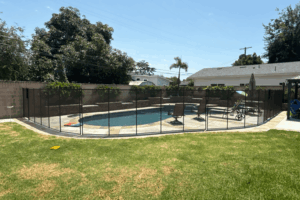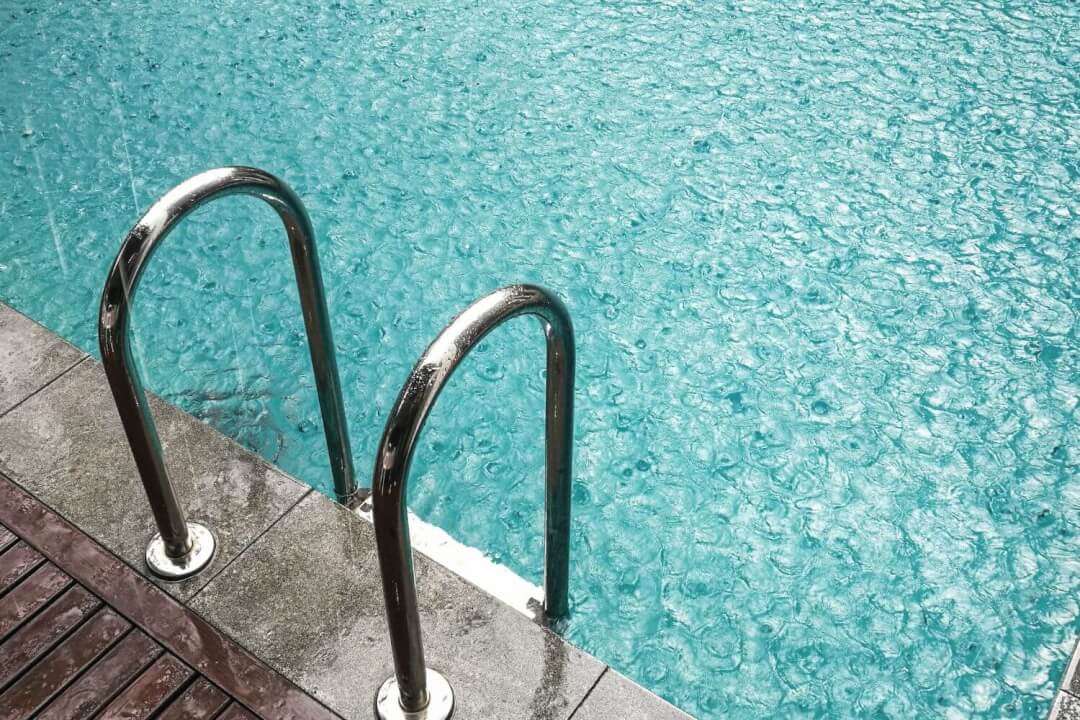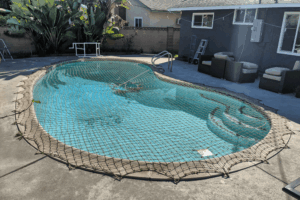
Do You Really Need Pool Safety Products If You Don’t Have Kids?
Think pool safety products are only for families with kids? Discover why fences, nets, and alarms matter for guests, pets, and liability, even if you don’t have children.

During swim season, the weather your pool experiences can create a pleasing backyard oasis, send you running indoors for your own safety, or impact the health of your pool’s water or the condition of your swimming pool accessories. From nearby lightning while swimming to cleaning up pool storm damage, as a pool owner, Mother Nature can significantly impact your enjoyment and the cost of ownership. Understanding the risks the weather poses to your pool before it strikes can help ensure everyone has a fun and safe time swimming, playing, or relaxing in and around the pool.

Outdoor swimming pools, whether inground or above ground, are subject to the elements, and so are the people using them. As the pool owner, you need to ensure you have the swimming pool safety barriers necessary to prevent unsupervised access to the swimming pool by children, pets, and adults when conditions aren’t safe. Accidental drowning injuries cause thousands of deaths annually, and during inclement weather, swimmers may be more easily disoriented, suffer injuries from environmental factors, or find themselves at increased risk of fatigue. Enforce any pool weather closure by securing your removable mesh pool fence, swimming pool safety cover, or pool safety net, preventing water entry and lowering your risk of accidents or injuries.
While your outdoor pool may not be as protected from the elements as an indoor pool, remember that it is designed to be in those elements. Your primary concerns as a pool owner are threefold:
Electricity and water don’t mix. Never use the swimming pool when lightning activity is in your immediate area. Lightning seeks the path of least resistance to reach the ground, often striking the tallest object and spreading through other conductive objects touching or near it. This can include pool structures, accessories, or human bodies. Lightning can also strike the pool’s surface, sending electricity through anyone in or around it.
The American Red Cross recommends a 30/30 rule when determining whether it’s safe to use the pool when lighting is present.
Sustained winds and high-powered gusts present weather challenges to pools and swimmers alike. High winds can bring airborne debris that damages pool accessories, like slides or fences, and contaminates the water with dirt, dust, and trash. This debris can also present a danger to swimmers, who can be struck, have trouble breathing through the airborne dust, or suffer eye injuries. Winds can also make the water choppy and turbulent, putting weaker or smaller swimmers at a heightened risk of drowning.
As wind speed increases, consider closing your pool for the safety of your loved ones. While a fence is a great safety barrier to prevent unsupervised access, such as to prevent swimming while lightning is nearby, it does little to protect the water itself. A swimming pool safety net can prevent larger debris from entering the swimming pool while swimming pool safety covers can also effectively keep out dirt and dust.
Rain storms may seem like innocuous pool weather events, but care should still be taken to protect your swimmers. A steady downpour can cause inexperienced swimmers to become disoriented, and rain storms can easily turn into thunderstorms with lightning. Swimming in any storm exposes your pool area to higher winds and added contaminants, including both air and waterborne dust and chemicals. Curtains of rain can also make it harder for those outside the pool, like the responsible adult serving as a water watcher for kids, to see a dangerous situation developing in the pool itself.
Close your pool anytime weather conditions become violent enough to put swimmers at risk. After the rainstorm, test your pool’s water and rebalance it. Even in areas where the rainwater is relatively free of dirt and biological contaminants, it’s still adding an additional volume of liquid to the pool, throwing off your pH, alkalinity, hardness, and sanitizer levels.

When the weather warms, the pool is a popular place to beat the summer heat. From taking a quick dip to cool off to catching some rays in order to perfect your tan, most pool owners can’t wait for summertime fun. It’s important to remember, however, that while the sun can give us some much-needed vitamin D, overexposure to UV radiation can be dangerous. In addition, high temperatures and dry conditions can increase the rate of evaporation, stealing your pool’s water volume while UV radiation further degrades the remaining chemicals you worked so hard to balance.
In the summer, plan your swimming schedule to allow for frequent breaks to reapply waterproof sunscreen and rehydrate, or avoid pool use when the sun is at its highest. Using a solar cover or swimming pool safety cover when the pool isn’t in use can help control evaporation and protect your pool and the water in it from UV damage.
Cold temperatures can lead to rapid body temperature loss, hypothermia, and death, especially in young or elderly swimmers. Meanwhile, freezing water can put your pool’s structure, liner, pipes, and fixtures at risk of frost damage or bursting under the increasing pressures caused by ice forming in an enclosed space. Anytime sustained low temperatures are expected, such as over the winter months, your pool should be winterized for protection, and swimmers should be kept away from the pool area, whether filled or partially emptied, as part of the winterization process.
Winterization prepares your pool for weather that’s far below freezing, and pool safety barriers can help keep your loved ones out of harm’s way by preventing pool access. It’s important to note that even though you may not have anyone actively swimming, lighting remains a danger during colder months as the air holds less moisture overall. This can lead to the rare and dangerous phenomenon known as “thundersnow”, a winter storm that includes lightning strikes with falling temperatures and lack of visibility from snow flurries.
Before allowing anyone into your pool area, ensure you know what weather to expect and take the appropriate safety precautions. Modern meteorological predictions are increasingly accurate, powered by more sensitive instruments, better computer modeling, and a deeper understanding of the world around us. Check the forecast before planning an event at your pool and frequently as it approaches to ensure you’re ready to provide a safe area for swimmers and non-swimmers alike.
Your local independent pool installation professional is your go-to resource for pool safety barrier installation, repair, and inspection. They’ll schedule a time to visit your pool, take measurements, talk to you about your needs, and then provide an estimate that lets you make an informed decision. Find out how cost-effective peace of mind is. Get your free quote from your neighborhood All-Safe Pool pro today.

Think pool safety products are only for families with kids? Discover why fences, nets, and alarms matter for guests, pets, and liability, even if you don’t have children.

When most people think about pool safety, they picture a

Not every city has the same pool safety requirements. Learn how to plan a code-compliant barrier system using fences, nets, or covers while meeting local standards.
Enter your zip code to locate an independent installer in your area
Enter your zip code to locate an independent installer in your area
Enter in your zip code to let us know where your pool is located.
Due to the many variations in monitors, phones, and browsers, color samples and product examples may appear different on different screens. Computers and mobile devices are not all calibrated equally and color reproduction on the Internet is not precise. The same is true for printed items such as brochures and other sales literature.
In addition, the colors of our products photograph differently under different lighting conditions. For example, photos taken in full sunlight will vary from photos taken on a cloudy or overcast day. Similarly, shadows from nearby objects can affect the color and transparency of our products. If a precise color or specific shade is important, please inspect the actual color of your product prior to installation.
Many of our products’ materials are not available through typical stores and vendors and therefore must be custom manufactured specifically for our use. In order to control costs and provide you with the best value possible, our raw materials are produced in large batches and can often take several months to receive. The colors of our materials can, and often do, vary slightly from batch to batch. Although we make every effort to minimize color variations, we cannot be responsible for these differences when they occur. If a precise color or specific shade is important, please inspect the actual color of your product prior to installation.
For example, we use the name “putty” to describe some of our products. Your idea of the color “putty” may be different than someone else’s idea of “putty”. In addition, products may have the same color name but may not be the exact same color. For example, we have different shades of “black”. Please do not order using color names as your only guide. If a precise color or specific shade is important, please inspect the actual color of your product prior to installation.
If it is important that your product be an exact color or shade, it is highly recommended that you inspect the actual product prior to its installation and address any concerns with your local independent installer. Most independent installers do not offer refunds or accept returns due to color variations.